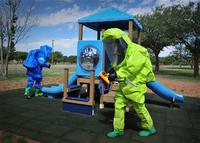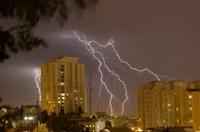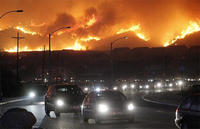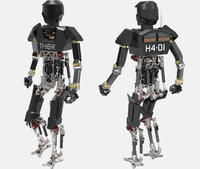-
Largest annual homeland security exercise to star Monday in Indiana
DHS will be conducting its largest training event of the year next week in Butlerville, Indiana. The event will involve 5,500 people from twenty-three states, and will start next Monday.
-
-
Quake Summit 2013: showcasing research on earthquakes, tsunamis
Members of a national earthquake simulation research network next week will gather at the University of Nevada, Reno (UNR), for Quake Summit 2013, a scientific meeting highlighting research on mitigating the impact of devastating earthquakes and tsunamis. Titled “Earthquake & Multi-Hazards Resilience: Progress and Challenges,” the annual summit of the 14-site George E. Brown Network for Earthquake Engineering Simulation (NEES), will run from 6 August through 8 August at UNR’s Joseph Crowley Student Center.
-
-
Online tools accelerate progress in earthquake engineering, science
A new study has found that on-line tools, access to experimental data, and other services provided through “cyberinfrastructure” are helping to accelerate progress in earthquake engineering and science. The cyberinfrastructure includes a centrally maintained, Web-based science gateway called NEEShub, which houses experimental results and makes them available for reuse by researchers, practitioners, and educational communities. NEEShub contains more than 1.6 million project files stored in more than 398,000 project directories and has been shown to have at least 65,000 users over the past year.
-
-
Simulations help in studying earthquake dampers for structures
Researchers have demonstrated the reliability and efficiency of “real-time hybrid simulation” for testing a type of powerful damping system that might be installed in buildings and bridges to reduce structural damage and injuries during earthquakes. The magnetorheological-fluid dampers are shock-absorbing devices containing a liquid that becomes far more viscous when a magnetic field is applied.
-
-
Hazmat Challenge tests skills of hazmat response teams from three states

Twelve hazardous materials response teams from New Mexico, Missouri, and Oklahoma will test their skills at the 17th annual Hazmat Challenge, which will be held 30 July through 2 August at Los Alamos National Laboratory.
-
-
Humanoid robot ready for DARPA’s Robotics Challenge trials
A Korean research institution joins with nine U.S. universities to enter the team’s DRC-HUBO, a humanoid robot, in DARPA Robotics Challenge (DRC). The competing robots will have to fulfill eight tasks at the competition, among them driving a utility vehicle, walking across rough terrain, climbing a ladder, and using hand tools.
-
-
Non-toxic fire retardants developed
Fire retardants are often extremely harmful to health. Despite this, they are found in many types of synthetic materials which would otherwise ignite quickly. Researchers have now succeeded in producing non-harmful flame retardants.
-
-
New underwater robots mimic designs found in nature
In recent years, robotic underwater vehicles have become more common in a variety of industrial and civil sectors. Now, a new class of underwater robot has emerged that mimics designs found in nature. These “biomimetic” vehicles promise to lead to new underwater technologies that could help the oil and gas industry, underwater humanitarian demining, environmental monitoring, search and rescue operations, anti-terrorist activities, harbor surveillance, coastal security and fisheries management, and more.
-
-
Young engineers compete in underwater robotics race
Student-built autonomous underwater vehicles will speed through the depths of a Navy pool in a battle for supremacy at the 16th International RoboSub Competition. The competition is being held this week (22-28 July). In addition to building autonomous underwater vehicles, teams are also responsible for creating Web sites and writing journal papers that outline their work.
-
-
Houston, Texas boasts world’s best lightning detection system

With thousands of strikes each year, Houston is the lightning center of Texas and one of the world’s most lightning-prone areas. Studies show about 1,800 thunderstorms pound the Earth at any given moment, resulting in about fifty lightning strikes every second. The country’s best system to detect lightning strikes — located in and around the Houston area — just got better, thanks to a complete overhaul and new software.
-
-
Advancements in technology making it easier to fight wildfires
Following the Arizona wildfire disaster, many have been suggesting that new regulations are needed to control the spread of wildfires. Experts say that advancements in technology may well offer a more effective approach to saving lives and making it easier for firefighters to control wild blazes.
-
-
Firefighting experts calling for easing environmental restrictions on prescribed burns
In the aftermath of the Arizona wildfire which killed nineteen firefighters in Yarnell, Arizona, there are growing calls for easing environmental restrictions which currently limit brush clearing and prescribed burns. It typically costs $5 per acre to conduct a prescribed burn in the wilderness, and about $50 per acre near residential areas. Thinning an area with chain saws and other equipment can cost around $500 per acre. These figures are small when compared to the $1,200 per acre cost of fighting the wildfire in Arizona.
-
-
Obama says Arizona wildfire deaths open up broader questions

President Barack Obama said on Monday that several states need to reassess their wildfire management policies in the aftermath of the death of the nineteen firefighters who died battling an Arizona blaze.
-
-
Remote-controlled cockroaches to help in search-and-rescue missions
Researchers are using video game technology to remotely control cockroaches on autopilot, with a computer steering the cockroach through a controlled environment. The researchers are using the technology to track how roaches respond to the remote control, with the goal of developing ways that roaches on autopilot can be used to map dynamic environments — such as collapsed buildings.
-
-
Robots to assist humans in mitigating, recovering from future natural and man-made disasters

The goal of DARPA Robotics Challenge (DRC) is spur development of advanced robots that can assist humans in mitigating and recovering from future natural and man-made disasters. Seven teams will receive DARPA support to compete with an ATLAS Robot in 2013.
-
More headlines
The long view
Using Drone Swarms to Fight Forest Fires
Forest fires are becoming increasingly catastrophic across the world, accelerated by climate change. Researchers are using multiple swarms of drones to tackle natural disasters like forest fires.
